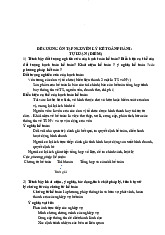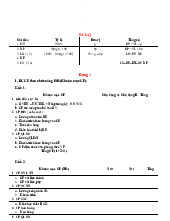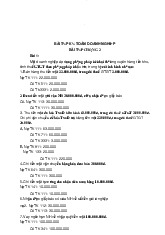







Preview text:
lOMoARcPSD|453 155 97 lOMoARcPSD|453 155 97
ASSIGNMENT ON SCIENTIFIC RESEARCH METHODOLOGY
Write a research proposal on a topic of your choice
basing on the following template 1.COVER PAGE HANOI OPEN UNIVERSITY FACULTY OF ENGLISH
ASSIGNMENT ON SCIENTIFIC RESEARCH METHODOLOGY B.A Thesis Proposal
EFFECTS OF USING MULTIMEDIA TOOLS IN LEARNING
ENGLISH SPEAKING SKILLS FOR SOPHOMORE STUDENTS AT UNIVERSITY IN HANOI
(ẢNH HƯỞNG CỦA VIỆC SỬ DỤNG CïNG CỤ ĐA PHƯƠNG
TIỆN TRONG VIỆC HỌC KỸ NĂNG NîI TIẾNG ANH CHO
SINH VIæN NĂM HAI TẠI TRƯỜNG ĐẠI HỌC Ở HË NỘI) CANDIDATEÕS FULL NAME Date of birth: VU THANH LINH Group: K29A01
Field: English Language Hanoi Ð 2023 2. TABLE OF CONTENTS Contents Page number 1. Introduction 1 1.1. Rationale É 1.2. Aim and objectives É 1.3. Scope of the study É 1.4. Research questions É 1.5. Structure of the study É 2. Literature Review É 2.1. Overview of previous studies É 2.2. Theoretical framework É
3. Proposed Research Methodology É 3.1. Research approaches É 3.2. Population and sample É 3.3.
Research methods (data collection instruments/tools, procedure, data analysis)
4. Proposed Chapter Outline É References É 3. MAIN TEXT (IN DETAILS) 1. Introduction 1.1. Rationale
In our interconnected world, effective communication is
paramount for success across various domains. Language
serves as the primary tool for communication, and
without it, achieving seamless interaction becomes
challenging. Given that English is spoken worldwide and
recognized as the global language, it fulfills the role of
facilitating communication across diverse regions, states,
nations, and continents. In the realm of acquiring a
foreign or second language, speaking stands out as the
most crucial skill among the four language skills, playing
an essential role in effective language learning. The
effects of employing multimedia tools in learning English
speaking skills for students constitute a significant and
timely investigation. Multimedia functions as a crucial
instrument that can be incorporated into contemporary
language classrooms to exert a positive impact on the
language learning journey (Chapelle & Erik, 2016).
Multimedia tools encompass a diverse range of resources,
including videos, audio clips, interactive applications, and
virtual simulations. These tools offer a dynamic and
immersive learning experience that goes beyond
conventional teaching methods. As students engage with
multimedia content, they are exposed to authentic
language usage, diverse accents, and real-world
communication scenarios, providing a more holistic and
practical approach to language acquisition. Moreover, the
integration of technology into language learning has the
potential to address the individualized needs of students.
The flexibility and accessibility of multimedia tools
enable learners to progress at their own pace, revisit
challenging material, and tailor their learning experience
according to their preferences. This adaptability fosters a sense of autonomy and self-directed learning,
empowering students to take an active role in their language development.
The purpose of this research is to find out the ways to
apply multimedia improve learning English Speaking
Skills for sophomore English-majored students . This
study is relevant because the findings gave some
important insights into the way speaking is being taught
currently by English language teachers at university level.
The target group was benefited with some current
tendencies related to using multimedia tools in learning
English speaking skills that were applied by their
teachers. On the other hand, students' ability to apply
multimedia tools has a great relevance as well as the
experience the researchers have is of significant help
when trying to figure out the effect of using multimedia in
learning English Speaking Skills for sophomore English-
majored students at university in Hanoi. Therefore, the
topic Ò Effect of using multimedia in learning English
Speaking Skills for sophomore English-majored students
at university in HanoiÓ was chosen. 1.2. Aim and objectives 1.2.1. Aim
The study aims to improve English speaking skills for
the second-year students by using multimedia tools. 1.2.2. Objectives
To generalize the effectiveness of multimedia in
learning English Speaking Skills
To identified if multimedia applied in learning
English Speaking Skills at university in Hanoi
To propose the ways to apply multimedia improve
learning English Speaking Skills for sophomore English-majored students 1.3. Scope of the study
Academic scope: English speaking skills
Second- year students at university in Hanoi 1.4. Research questions
How effective is multimedia in enhancing English speaking skills?
How is multimedia currently applied in learning
English speaking skills at the University in Hanoi?
In what ways can multimedia be effectively integrated
to enhance English speaking skills for sophomore English-majored students?
1.5. Structure of the study The
study is divided into 5 chapters Chapter 1: Introduction
Chapter 2: Literature review
Chapter 3: Methodology
Chapter 4: Findings and Discussion
Chapter 5. Conclusion 2. Literature review
Literature review is divided into two parts : Overview of
previous studies and theoretical background. The first part
of the literature review summarizes previous research on
using multimedia tools to improve English speaking
skills. The second part of the review is to provide
definitions of English speaking skills , multimedia , and other related concepts.
2.1. Overview of previous studies
Many recent studies have focused on improving speaking
skills and the importance of multimedia tools in the
process of developing speaking skills for sophomore students to learn English.
According to RifaÕat (2018), speaking stands out as the
most crucial among the four simplex skills (listening,
reading, speaking, writing). This is underscored by the
fact that individuals proficient in a language are
commonly labeled as 'speakers' of that language, implying
that competence in speaking encompasses proficiency in all other language skills.
Dewi (2016) contends that there are various factors
contributing to the lack of success in students' speaking
skills. These include: English not being utilized beyond
the classroom or in the local community as a foreign
language, Limited exposure to English in the surrounding
environment, English learning on campus giving
insufficient attention to speaking skills, with a
predominant focus on structural aspects and vocabulary
enrichment, Feelings of shame and fear of making
mistakes during speaking exercises, and English not being
a primary requirement, except in cases where there is an
opportunity to pursue education or tourism in an English- speaking country.
Multimedia materials fall within the category of non-
printed resources, as noted by Richard ( 1990). Richard
defines multimedia learning materials as the utilization of
computers to present and integrate text, graphics, audio,
video, and animation, accompanied by links and tools that
facilitate user interaction, creation, and communication.
Consequently, for effective teaching and learning, the
presence of a computer is necessary to coordinate the
presentation of visual and auditory content, provide
interactive features for users, establish links connecting
information, offer navigational tools for information
access, and enable users to collect, process, and convey
their own information and ideas.
Burns and Joice (1993) assert that a crucial element of
speaking is its inherent connection to a context. Speaking
involves the use of language to fulfill social functions,
and individuals, when speaking, select linguistic forms
that are pertinent and meaningful within the given cultural and social context.
There is a belief that introducing a multimedia
environment can enhance students' speaking skills. For
example, the utilization of videos and images has the
potential to engage students, capturing their attention and
motivating them to express themselves, as suggested by Damayanti (2017).
However, few researchers have taken the multimedia tool
to improve second- year students at university in Hanoi
when learning to speak English. 2.2. Theoretical framework
2.2.1 Definition of multimedia
Multimedia, according to Mayer (2001), is the
amalgamation of diverse digital media forms, including
text, images, sound, and video, fused into a cohesive and
interactive application or presentation. The primary
objective is to effectively communicate a message or
convey information to an audience. Mayer highlights the
advantageous utilization of multimedia by tapping into
humans' visual and auditory processing capabilities. By
incorporating both channels simultaneously, multimedia
optimally engages these distinct processing systems.
Furthermore, the integration of text and graphics fosters
meaningful connections, potentially leading to a more
profound comprehension and the development of
enhanced mental models compared to the understanding
derived from either component in isolation.
2.2.2 Definition of speaking skills
Luoma (2004) defined speaking as an interactive process
of constructing meaning that involves producing,
receiving and processing information.
According to Tarigan (2008), speaking is a form of
communication that influences our daily life. This means
that speaking is a means of communication and it affects
our lives. Whereas, according to Burn (2012), speaking is
a highly complicated and dynamic skill that involves the
use of several simultaneous processes- cognitive, physical
and socio-cultural and a speakerÕs knowledge and skills
have to be activated drastically in real- time.
Based on the aforementioned explanation, the researchers
conclude that speaking serves as a method for articulating
emotions, manifested through oral language interactions
between two or more individuals. The act of speaking
enables individuals to engage in verbal communication
and articulate their ideas, as highlighted in the study.
During spoken communication, implied meanings are
often embedded in the chosen words. Speaking is
identified as a skill that reflects an individual's
communicative competence. It is classified as one of the
productive skills, indicating its development subsequent
to listening, a receptive skill. Thus, speaking is not solely
about verbalizing opinions and thoughts but is a
productive oral activity that encompasses various aspects.
5.2.3 The use of multimedia tools
Mino and Butler (1995) identified a positive association
between an individual's communication skills and their
engagement in an interactive media setting. The research
proposed the utilization of audiotapes lectures and reading
assignments as strategies to enhance students' oral
communication skills beyond the traditional classroom
setting. The interactive media method provides increased
opportunities for verbal communication exposure,
facilitating comprehensive coverage of the course within a suitable time frame.
Muslem and Abbas (2017) emphasized the significance of
the immersion technique, which involves experiential
learning to help students grasp and actively participate in
the target language, enhancing their listening, speaking,
reading, and writing skills. They suggest that multimedia,
complemented by language-focused video clips and
presentations, can be a valuable resource for teachers.
This approach offers individuals a chance to repeat words
or sentences, facilitating comprehension of both lexical
and phonological aspects of sentence usage.
The findings presented by Bahadorfar and Reza (2014)
indicated that multimedia has a positive impact on
individual interaction, fostering enhanced self-esteem and
motivation. This technological tool is noted for its rapid and accurate information processing capabilities,
significantly transforming students' approaches to work,
learning, and communication. The study proposed that
integrating theoretical and practical aspects of second
language acquisition through modern technical methods
can yield effective results in developing speaking skills.
Lastly, it recommended English language educators to
encourage students, particularly children, to leverage
technology for refining and honing their speaking abilities.
In addition , Windihastuti (2013) conducted a study
focusing on the enhancement of students' speaking skills
through the utilization of picture series. The research
involved tenth-grade students from SMA Negeri 6
Surakarta within a specific time frame from January to
April. Data collection encompassed observations,
interviews, images, and tests. The study yielded positive
results, indicating that the combined use of picture series,
teacher explanations, and drilling techniques proved
effective in enhancing students' narrative speaking skills.
The integration of video into speaking-focused learning
yields multiple benefits. Students can review their own or
their peers' performances, facilitating the correction of
errors and fostering a heightened sense of self-
development. Teachers, as highlighted by Hartsell and
Yuen (2006) , can leverage students' video recordings to
assist in improving speaking fluency by observing and rectifying mistakes.
In summary, this part investigated a number of previous
studies on improving speaking skills, the importance of
multimedia materials in the process of developing
language skills for sophomore students and theoretical
background relating to multimedia materials for language
learning and the use of multimedia tools for language learning.
3. Proposed Research Methodology 3.1. Research approaches
To reach the goal of the study, the writer used quantitative
approaches. By virtue of the quantitative method, the data
were collected for the study including the potential benefits, challenges, recommendations to apply
multimedia improving speaking skills for sophomore English-majored students .
A survey questionnaire was applied to investigate the
perceptions and experiences of university students
regarding using multimedia in learning English speaking
at university in Hanoi. By delving into thoughts and
experiences which aim to gain a comprehensive
understanding of the potential benefits, challenges, and
overall impact that using multimedia tool may have on
second Ð year studentÕs English speaking skills.The
survey questionnaire results were interpreted and used as
a basis to propose some recommendations to apply
multimedia improving speaking skills for sophomore English-majored students . 3.2. Population and sample
The population of present study is the second- year
English majors at university in Hanoi . The sample of the
study contained of 36 second- year students majoring in
English language chosen randomly from the total
population . The participants belong to different classes,
each class included 3 students. 3.3. Research methods
To achieve the aim and objectives, quantitative methods
were used. The quantitative approach was applied to
investigate and analyze the difficulties faced by the
second-year students of FOE, HOU when using
multimedia learning English speaking skills. Besides, the
quantitative approach was also used to propose some
helpful recommendations to apply multimedia improving
speaking skills for sophomore English-majored students .
The survey questionnaire consisted of 3 multiple-choice
questions, 7 questions with 3 ranking scale responses and
1 open question. The aim was to gain a comprehensive
understanding of the potential benefits, challenges, and
overall impact that using multimedia tool may have on
second Ð year studentÕs English speaking skills.The
students were given 10 minutes to complete the survey anonymously.
Before analyzing the effect of multimedia tool to the
students in learning English speaking skills, the gathered
data was prepared. The dataset was checked for missing
data and outliers. For this the Òoutlier labeling ruleÓ was
used. All values outside the calculated range were
considered outliers (Hoaglin & Iglewicz, 1987). The data
was then analyzed using statistical software SPSS.
4. Proposed chapter outline (Headings)
Chapter 1: Introduction 1.1. Rationale
1.2. Aim and objectives of the study 1.3. Scope of the study 1.4. Research questions 1.5. Methods of the study 1.6. Structure of the study
Chapter 2: Literature review
2.1. Overview of previous studies
2.2. Theoretical background/frameworks 2.2.1 Definition of speaking
2.2.2 Definition of a strategy Chapter 3: Methodology 3.1. Research approaches 3.2. Population and sample 3.3. Research methods Chapter 4: Findings and Discussion 4.1. Findings
4.1.1 Real situation of using multimedia tool to learn
English speaking skills of the second- year students at university in Hanoi 4.1.2ÉÉÉÉÉÉÉÉÉÉ 4.2. Discussion 4.2.1 Evaluate the results
4.2.2 Recommendations to apply multimedia tool
improving speaking skills for sophomore English-majored students .
4.2.3 Limitations of the study Chapter 5: Conclusion References
Burns, Anne. (2012). Teaching speaking: A holistic
approach. New York: Cambridge University Press.
Luoma, S. (2004). Assessing speaking. Cambridge University Press.
Tarigan, H. (2008). Speaking: As A Language Skill. Bandung: Angkasa.
Dewi, K. (2016). The Correlation Of SMA StudentsÕ
Habit In Watching Movie And Their Speaking Skill.
MENDIDIK: Jurnal Kajian Pendidikan Dan Pengajaran, 2(2), 112Ð 118.
RifaÕat, A. A. (2018). Stimulating You To Speak; A
Strip Story As A Technique In Teaching Speaking.
English And Literature Journal, 5(1), 12Ð21.
Richard J. C. (1990). Developing English Speaking
Activities. From Theory to Practice. Retrieved from
http://www.professorjackrichards.com/pdfs/developing- classroom-speaking
Burns, A. & Joice, H. (1993). Focus on speaking (2nd
edition). Sydney: Macquarie University.
Damayanti, E. (2017). Improving the studentsÕ speaking
skill through the use of video at class X multimedia
program of SMK Muhammadiyah 2 Klaten Utara in the
academic year of 2016/2017. English Language Teaching Journal, 6(2), 77Ð84.
Mayer, R. E. (2001). Multimedia learning. Cambridge,
UK: Cambridge University Press.
Mino, M., & Butler, M. (1995). Improving oral
communication competency: An interactive approach to
basic public speaking introduction. Basic Communication Course Annual, 7(1), 7.
Bahadorfar, M., & Reza, O. (2014). Technology in
teaching speaking skill. IAMURE International Journal of
Multidisciplinary Research, 2(4), 9Ð13.
Windihastuti, R. (2013). Improving studentsÕ speaking
skill by using picture series (A classroom Action
Research Conducted at the Tenth Grade of SMA Negeri 6
Surakarta in the Academic Year of 2012/2013) [Doctoral
dissertation, University as Sebelas Maret].
Hartsell, T., & Yuen, S. C.-Y. (2006). Video Streaming in Speaking Online Learning. 13.
Muslem, A., & Abbas, M. (2017). The effectiveness of
immersive multimedia learning with peer support on
English speaking and reading aloud. International Journal of Instruction, 10(1), 203Ð218.
https://doi.org/10.12973/iji.2017.10113a
Chapelle, C., & Erik, V. (2016). 20 years of technology
and language assessment in language learning and
technology. Language Learning and Technology, 20(2), 116Ð128. Research schedule Research phase
Objectives (with examples) Deadline (with examples) 1. Background ●
Meet with supervisor 30th February research and for initial discussion literature review ● Conduct a more extensive review of relevant literature ● Refine the research questions ● Develop a theoretical framework 2. Research ● Design questionnaires 25th March design planning ● Identify online and offline channels for recruiting participants ● Finalize sampling
methods and data analysis methods 3. Data ●
Recruit participants and 24th April collection and send out questionnaires preparation ● Conduct semi- structured interviews with selected participants ● Transcribe and code
interviews and clean survey data ● Statistically analyze 22nd May 4. Data analysis survey data ● Conduct thematic
analysis of interview transcripts ● Draft the results and discussion chapters 5. Writing ● Complete a full thesis 17th July draft ● Meet with supervisor to
discuss feedback and revisions 6. Revision ● Redraft based on 30th August feedback ● Get supervisor approval for final draft ● Proofread ● Print, bind and submit Formatting guidelines Font: Times New Roman Size: 13
Line spacing: 1.3 lines
Page setup: Top: 3 cm, Bottom: 3 cm, Left: 3.5 cm, Right: 2 cm Paper size: A4
Page number: Bottom of page/Center
Number of pages: 16 pages Before: After: 0




